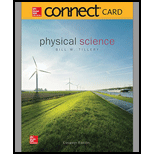
l. The plane of Earth’s orbit is called the
a. plane of Earth.
b. plane of the solar system.
c. plane of the ecliptic.
d. plane of the Sun.
The name of the plane of Earth’s orbit from the following options:
Plane of Earth.
Plane of the solar system.
Plane of the ecliptic.
Plane of the Sun.
Answer to Problem 1AC
Solution:
Option (c) is correct.
Explanation of Solution
Introduction:
Every planet in the Solar System, move around the sun in an elliptical orbit almost in a circular path in the same direction. This path is called the plane of a planet’s orbit.
Explanation:
Reason for the correct option:
The earth has its own orbit and move around the sun once a year or 365 days. This path in a 2 dimensional flat shape is called the plane of earth’s orbit. If anything move through it can be seen in front of or behind the sun. So this is called the plane of ecliptic.
Hence, option (c) is correct.
Reason for incorrect options:
Option (a) is incorrect. This is because the earth is a spherical object which is a 3 dimensional in shape. But ‘Plane’ means it should be a 2 dimensional shape. So if the earth has been cut in a cross section, which is called the plane of earth. For example, if it has been cut in the equatorial region in a 2 dimensional cross section that is called the plane of the earth in equatorial region. But, it’s not correct to call the plane of earth’s orbit as plane of the earth.
Option (b) is incorrect. This is because the solar system has a collection of 8 planets with their moons together with smaller bodies in the form of asteroids, meteoroids and comets. Each of them has certain orbits. So it’s not possible to call the plane of the earth’s orbit as plane of the solar system.
Option (d) is incorrect. This is because if the sun has been cut in a cross section that is called the plane of the sun. For example, if the sun has been cut in the axial region in a 2 dimensional cross section that is called the plane of the sun in axial region. But, it’s wrong to call the plane of earth’s orbit as the plane of the sun.
Hence, options (a), (b) and (d) are incorrect.
Conclusion:
Therefore, the plane of earth’s orbit is called the plane of the ecliptic.
Want to see more full solutions like this?
Chapter 16 Solutions
Connect Access Card for Physical Science
Additional Science Textbook Solutions
Sears And Zemansky's University Physics With Modern Physics
Physics for Scientists and Engineers: A Strategic Approach with Modern Physics (4th Edition)
The Cosmic Perspective Fundamentals (2nd Edition)
College Physics
Cosmic Perspective Fundamentals
Essential University Physics (3rd Edition)
- Explain why you might describe the orbital motion of the Moon with the statement, “The Moon is falling.”arrow_forwardDetermine the month and day when the Sun is at maximum altitude for an observer in Washington, D.C. (39N). What is the altitude of the Sun at this time? Answer: on or about June 21, 74.5arrow_forwardA high tide is occurring at Charleston, South Carolina (33N, 84W). (a) What other longitude is also experiencing a high tide? (b) What two longitudes are experiencing low tides?arrow_forward
 An Introduction to Physical SciencePhysicsISBN:9781305079137Author:James Shipman, Jerry D. Wilson, Charles A. Higgins, Omar TorresPublisher:Cengage Learning
An Introduction to Physical SciencePhysicsISBN:9781305079137Author:James Shipman, Jerry D. Wilson, Charles A. Higgins, Omar TorresPublisher:Cengage Learning Physics for Scientists and Engineers with Modern ...PhysicsISBN:9781337553292Author:Raymond A. Serway, John W. JewettPublisher:Cengage Learning
Physics for Scientists and Engineers with Modern ...PhysicsISBN:9781337553292Author:Raymond A. Serway, John W. JewettPublisher:Cengage Learning Physics for Scientists and EngineersPhysicsISBN:9781337553278Author:Raymond A. Serway, John W. JewettPublisher:Cengage Learning
Physics for Scientists and EngineersPhysicsISBN:9781337553278Author:Raymond A. Serway, John W. JewettPublisher:Cengage Learning Principles of Physics: A Calculus-Based TextPhysicsISBN:9781133104261Author:Raymond A. Serway, John W. JewettPublisher:Cengage Learning
Principles of Physics: A Calculus-Based TextPhysicsISBN:9781133104261Author:Raymond A. Serway, John W. JewettPublisher:Cengage Learning Horizons: Exploring the Universe (MindTap Course ...PhysicsISBN:9781305960961Author:Michael A. Seeds, Dana BackmanPublisher:Cengage Learning
Horizons: Exploring the Universe (MindTap Course ...PhysicsISBN:9781305960961Author:Michael A. Seeds, Dana BackmanPublisher:Cengage Learning




